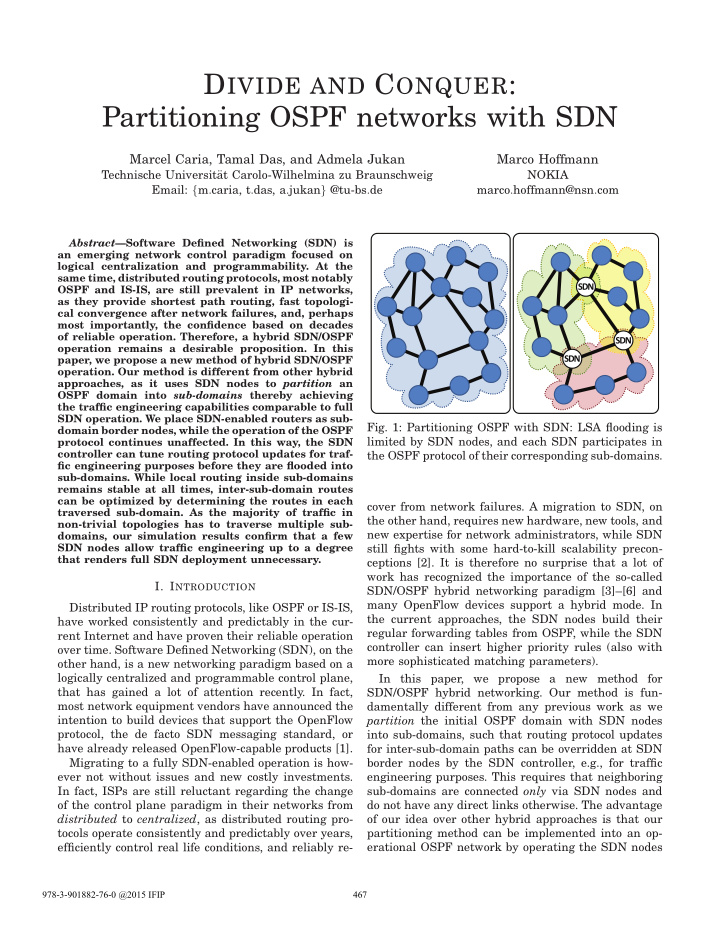



D IVIDE AND C ONQUER : Partitioning OSPF networks with SDN Marcel Caria, Tamal Das, and Admela Jukan Marco Hoffmann Technische Universit¨ at Carolo-Wilhelmina zu Braunschweig NOKIA Email: { m . caria, t . das, a . jukan } @tu-bs . de marco . hoffmann@nsn . com Abstract —Software Defined Networking (SDN) is an emerging network control paradigm focused on logical centralization and programmability. At the same time, distributed routing protocols, most notably S D N OSPF and IS-IS, are still prevalent in IP networks, as they provide shortest path routing, fast topologi- cal convergence after network failures, and, perhaps most importantly, the confidence based on decades of reliable operation. Therefore, a hybrid SDN/OSPF S D N operation remains a desirable proposition. In this S D N paper, we propose a new method of hybrid SDN/OSPF operation. Our method is different from other hybrid approaches, as it uses SDN nodes to partition an OSPF domain into sub-domains thereby achieving the traffic engineering capabilities comparable to full SDN operation. We place SDN-enabled routers as sub- Fig. 1: Partitioning OSPF with SDN: LSA flooding is domain border nodes, while the operation of the OSPF limited by SDN nodes, and each SDN participates in protocol continues unaffected. In this way, the SDN controller can tune routing protocol updates for traf- the OSPF protocol of their corresponding sub-domains. fic engineering purposes before they are flooded into sub-domains. While local routing inside sub-domains remains stable at all times, inter-sub-domain routes can be optimized by determining the routes in each cover from network failures. A migration to SDN, on traversed sub-domain. As the majority of traffic in the other hand, requires new hardware, new tools, and non-trivial topologies has to traverse multiple sub- new expertise for network administrators, while SDN domains, our simulation results confirm that a few SDN nodes allow traffic engineering up to a degree still fights with some hard-to-kill scalability precon- that renders full SDN deployment unnecessary. ceptions [2]. It is therefore no surprise that a lot of work has recognized the importance of the so-called I. I NTRODUCTION SDN/OSPF hybrid networking paradigm [3]–[6] and many OpenFlow devices support a hybrid mode. In Distributed IP routing protocols, like OSPF or IS-IS, the current approaches, the SDN nodes build their have worked consistently and predictably in the cur- regular forwarding tables from OSPF, while the SDN rent Internet and have proven their reliable operation controller can insert higher priority rules (also with over time. Software Defined Networking (SDN), on the more sophisticated matching parameters). other hand, is a new networking paradigm based on a logically centralized and programmable control plane, In this paper, we propose a new method for that has gained a lot of attention recently. In fact, SDN/OSPF hybrid networking. Our method is fun- most network equipment vendors have announced the damentally different from any previous work as we intention to build devices that support the OpenFlow partition the initial OSPF domain with SDN nodes protocol, the de facto SDN messaging standard, or into sub-domains, such that routing protocol updates have already released OpenFlow-capable products [1]. for inter-sub-domain paths can be overridden at SDN Migrating to a fully SDN-enabled operation is how- border nodes by the SDN controller, e.g., for traffic ever not without issues and new costly investments. engineering purposes. This requires that neighboring In fact, ISPs are still reluctant regarding the change sub-domains are connected only via SDN nodes and of the control plane paradigm in their networks from do not have any direct links otherwise. The advantage distributed to centralized , as distributed routing pro- of our idea over other hybrid approaches is that our tocols operate consistently and predictably over years, partitioning method can be implemented into an op- erational OSPF network by operating the SDN nodes efficiently control real life conditions, and reliably re- 978-3-901882-76-0 @2015 IFIP 467
Recommend
More recommend